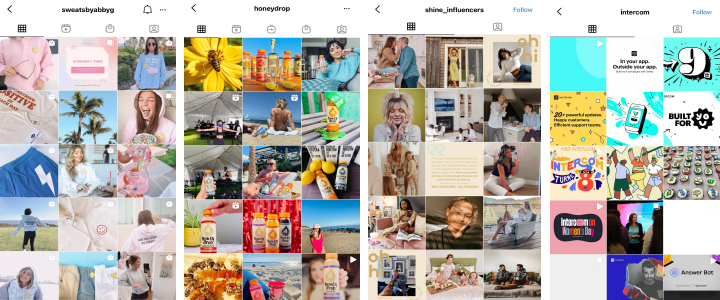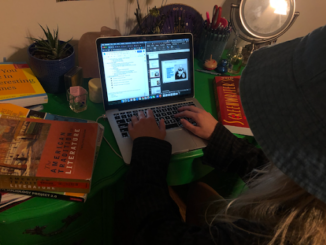
It is no surprise that social media revolutionized marketing campaigns.
With the COVID-19 pandemic, companies have had to rely on social media more than ever to market themselves to stay afloat through promoting brand awareness and consumer relationships.
“We are working to guide talent in the right direction of just how to navigate social media in this time because obviously this has never happened in the world,” Sana Kurani, talent manager with Shine Talent Group.
Companies have used their social media presence to continue to market themselves in these times of crisis, while simultaneously being sensitive to the current social and political climate.
What were the biggest obstacles during the COVID-19 pandemic?
When jeans became sweatpants, and 6-feet apart became the new normal, many companies struggled to adjust to these social changes right away.
Andy Lorig, the CEO of Honey Drop, said the lockdowns led them to lose 60-70% of retail locations for their honey-infused lemonade including pop-up shops, yoga studios and lunch places. Because the pandemic strongly impacted their sales, they switched to selling directly to consumers.
“We took all of our marketing spend out of in-store demos, people going to events, travel, food, all the stuff that typically goes into in-person marketing experience and converted into influencer marketing,” Lorig said.
Lorig said the amount of money the company spent on advertising increased significantly during the pandemic.
Noah Santo, senior advertising major and former intern with Consumer Cellular at Performics, said their concern was not being able to sell enough through telemarketing.
“Probably the biggest obstacle was the fact that we have no actual brick and mortar stores,” Santo said. “We basically sell all of our phones and the grand pad out of places like Target, which is the main part of our business. With people obviously not leaving the house, we definitely had to push a lot of money towards e-commerce and social media.”

How did social media marketers adapt to COVID times?
Although sales are a top priority for many businesses, companies rely on their social media presence to stay relevant in a world that is glued to the internet.
Social media spending grew from roughly 13% of marketing budgets in February to almost one-quarter (23%) of total marketing budgets in June, according to a May 2020 survey of more than 270 top marketers at for-profit US companies reported by marketingcharts.com.
“Overnight, all of these companies, and all these businesses had to go online,” Profit said. “So all of a sudden, all of their in-person customer support interactions were cut off.”
Something that greatly helped businesses stay afloat during the pandemic is the use of influencer marketing. Companies would look for influencers, who are individuals with a large following on a given social media platform, to market their brands and accumulate loyal customers.
However, because many brands were not getting as much sales in the beginning of the pandemic, their focus shifted from promoting their companies as a whole to strictly increasing sales. This has been an obstacle because influencers are not necessarily trained sales people.
“A lot of brands kind of went under the water during the pandemic,” Kurani said. “And so now more than ever brands are focusing on increasing sales.”
Kurani said a big challenge during the pandemic was coaching influencers with what to say, without offending anyone.
“With the pandemic and everything that came with it, such as Black Lives Matter and all these social justice reforms that have been happening, we’ve been having to guide our influencers on what to say to their audiences,” Kurani said.
Olivia Proffit, the social media manager for Intercom, said she thinks that she used their social media account as a space that not only maintained good relationships with customers, but also understood what is and what is not appropriate during these uncertain times.
“There have been so many things going on in the world that lets us, I guess, be more human and reach our customers in a more empathetic and relationship building way,” Profitt said. “But at the same time, we have to be really sensitive about what’s going on in the world.”
Did consumers really continue to online shop during the pandemic?
In a time of economic crisis, it would seem that the incentive to shop for non-essential items would decrease.
Surprisingly enough, many clothing brands were able to stay afloat during the pandemic.
Abby Gearheart, a sophomore liberal arts major, founded Sweats by Abby G during the height of the pandemic, when everyone was staying at home in comfortable clothes, so this benefited her business.
“I think something that has helped me is a lot of people are transitioning to wearing comfortable clothes, rather than dressing up more,” Gearheart said. “So I think it was good to start a loungewear company during the pandemic rather than a typical clothing company.”
For Abby Maxon, sophomore business administration major, and Lauren Hill, freshman integrated marketing communication major, the cure to in-house boredom is online shopping.
Maxon said the influencers that she follows sway her to purchase certain products because they have established enough trust to make her think like she too would enjoy the product.
“I feel like before the pandemic, I never really used online shopping,” Maxon said. “I prefer to go and try stuff on, but now once you’re kind of forced to do everything online, I feel like that’s kind of how things have continued for me,” Maxon said.
When she is on platforms such as Instagram and Tiktok, Hill said she frequently comes across ads that interest her, and these influence her to shop more frequently during the pandemic.
“On Instagram, I will see a lot ads for clothing brands,” Maxon said. “And it’s usually things that I could see myself wanting or that are my style or marketed toward people my age and I end up often times looking at the websites from those ads.”
Which social media platform has been the most effective?
So, which social media platform is the best to market on? The truth is, it all depends on your target audience and their age demographic.
Lorig said Instagram and Facebook were the best platforms to reach their target audiences, due to more of their consumers being a part of Gen Z.
However, his team recently created a Tik Tok profile and they have been getting thousands of views on their posts.
Tik Tok’s algorithm is formulated to put content on viewers’ pages who are most likely to interact with the post. This helps them reach their target audiences faster.
“We automatically get 600 to 1,000 views when we’re only you know, followed by 15 people,” Lorig said. “So it’s pretty incredible to see something like that get that type of reach.”
Gearheart has had her fair share of luck when it comes to Tik Tok.
Gearheart put a lot of focus on Tik Tok marketing, by reaching out to top creators on the app to wear her merchandise to promote her business.
By the power of Tik Tok’s algorithm, one of Gearheart’s Tik Toks got over 115,000 views, which helped her business substantially.
Although Tik Tok is an emerging social media platform with millions of daily users, it is not necessarily the best platform for all companies to market their products and or services, due to the fact that the majority of account holders are Gen Z, who are individuals born between 1997-2015.
Santo said he believes that Facebook is the best platform for them, because their target audience is ages 55+.
“Facebook marketing in particular gives advertisers an immense ability to target extremely accurately and efficiently by location, age, interests and even marital status,” Santo said. “No dollars wasted by Facebook marketing.”
Rachel Troyer completed the reporting for this story in Jour 241 in Fall 2021 under the supervision of Dr. Christina Littlefield and Dr. Theresa de los Santos. Dr. Littlefield supervised the web version of the story.




